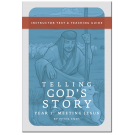Telling God's Story will eventually be a complete Bible curriculum for grades 1 through 12. However, this is not an age-graded program. Instead, each year's course can be used over a span of grade levels. The first four “years” of the program focus on Jesus in the New Testament at levels appropriate for children in grades 1 through 4. The next four years (for grades five through eight) will explore the Old Testament. Only the first two years are available thus far.
A Parent's Guide to Teaching the Bible explains the rationale for the program. Author Peter Enns purposely teaches first about Jesus since the stories of Jesus and the lessons that He teaches are easiest for young children to grasp. Enns follows with the Old Testament beginning about fifth grade level since older students are better able to understand the complexities involved in many Old Testament stories, and they are also able to understand foreshadowing and prophecies that relate to the New Testament.
While you can skip A Parent's Guide to Teaching the Bible, it is useful for understanding the author's perspective and methodology in regard to the curriculum. Some people have expressed concerns about Enns' orthodoxy. The Olive Branch Books website answers this concern with Enns' personal statement of his belief in the Nicene and Apostles' Creeds, the reality of sin, and the need for salvation through Jesus. From these books, it is clear that Enns believes in miracles. The content of these first two years does not challenge any core beliefs. Neither do they undermine parents who want to present a literal, seven-day creation. (Since the first two years are about Jesus, creation issues are not really addressed other than in A Parent's Guide, and the presentation there does not state anything controversial.) Rather than focus on areas of potential disagreement, Enns highlights key lessons to be learned from stories of the Bible—lessons that are common to all Christians. Consequently, the first two years of this program should work for all Christians including Orthodox and Catholic. With that said, some parents might feel uncomfortable with a few statements that Enns makes in A Parent's Guide to the effect that the Bible is NOT a “Christian owner's manual.” In contrast to some Christians, Enns would limit our ability to draw, directly from Scripture, answers to some of our modern day problems when such topics are not clearly addressed.
A much briefer, four-page introduction in each Instructor Text and Teaching Guide summarizes the approach presented in A Parent's Guide to Teaching the Bible, so you can begin by purchasing only the Instructor Text and Teaching Guide. You should start with Year 1: Meeting Jesus, but you could also start with Year 2: The Kingdom of Heaven. In these first four years, each guide is divided into the same nine sections: Stories Jesus Told, Miracles Jesus Did, Teachings of Jesus, The Sermon on the Mount, Jesus' Early Life, Jesus' Disciples, Opposition to Jesus, The End of Jesus' Life, and Supplemental Lessons on the passion, death, and resurrection of Jesus. Each of the first four programs cycles through these themes with different Scripture stories, moving a bit deeper at each level.
The Instructor Text & Teaching Guide is your core resource for each year and might even be the only item you need. It begins each lesson with “What the Parent Should Know”—background information about the Scripture passage and its meaning. This is followed by an adapted version of the Scripture passage to be read aloud to children. The passage is followed by the lesson which is text that you can read directly to children. Each lesson uses practical situations to help children understand the meaning and application of each story. If that is all you want to use, you could complete a lesson in one sitting.
But you can expand lessons with the Student Guide & Activity Page book for each level. Student Guides were created with contributions from at least seven different authors which accounts for the diversity in style and content throughout each book. There are coloring pages, games, memory work, hands-on projects, recipes, puzzles, cut-and-paste activities, art projects, music and art appreciation activities, and more. Coloring pages are the only one of these that you will find in every lesson. Rarely are there any pages that look like typical school workbook activities. Some of the activities are worthwhile and connect closely to the lesson while others remind me of Sunday school curriculum projects that are time consuming and relate very loosely to the story. Some activities will be too difficult for first graders. You should pick and choose which activities to use. You might find that the lesson taught from the Instructor Text gets the idea across without the need for any additional activities.
The program might be used in either homeschool or Sunday school type settings. Some activities require more than one child and will only be practical in a family with a few children close in age or in a class group. For homeschooling families, I think you could easily use the lessons from the Instructor Texts with the entire family. While preschoolers might not understand much, lessons are written such that even teens and adults can listen and learn without feeling like the presentation is “too young.” Activities in the Student Guides are generally best for the target audience of grades one through four, although you might occasionally include older and younger children. Permission is given to reproduce pages from a single Student Guide for immediate family use. (Licensing or other arrangements are needed for classroom use.) Using activities might expand a lesson over a number of days each week--the publisher suggests one week per lesson.
I recommend starting with the Instructor Text & Teaching Guide for Year 1 to see if the style of teaching works for your family. Then add the Activity Guide if you want to expand lessons with activities.












